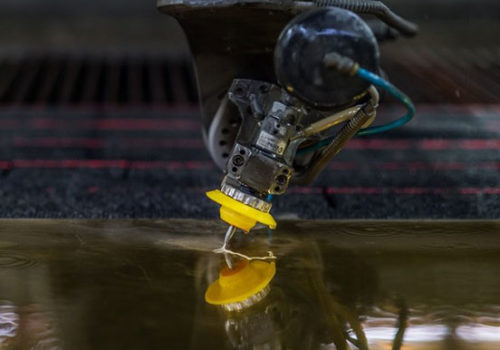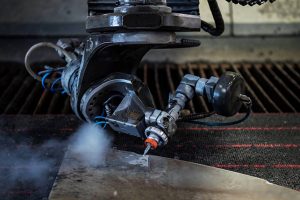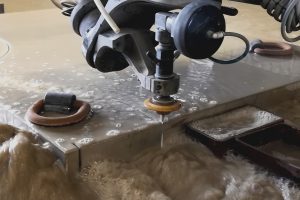Waterjet cutting is an extremely versatile cutting method that utilizes a high-pressure stream of water to accurately cut simple or intricate designs into a wide variety of materials. Waterjets are complex machines, and the shape of the cut is dependent on numerous variables. One challenge posed by waterjet cutting is taper, which can greatly affect the quality and accuracy of the cut. Taper is inherent to the waterjet cutting process. Whereas some types of taper are a result of problems in the cutting head or calibration and can be eliminated, other types of taper must be compensated for so that the cut part is not affected. Here we will discuss the different types of taper as well as what you can do to manage it.
What Is Taper?
To understand what taper is, you will first need to understand the meaning of kerf. Kerf refers to the amount of material the waterjet removes as it cuts through the material. Kerf width depends on various factors such as material type, material thickness, condition of the waterjet nozzle, and more. If a cut has taper, it means there is a difference in kerf width at the top of the cut versus the kerf width at the bottom of the cut. Taper can cause parts to fall outside of tight tolerances and design specifications, so it is important to understand what causes it and how it can be eliminated.
Different Types of Taper
Depending on the speed of the waterjet and the materials used throughout the process, there can be different kinds of taper. Four of the types include:
- V-Shaped Taper. This is the most common kind of taper, with more kerf width at the top of the cut than at the bottom. Usually associated with faster cutting speeds, V-shaped tapers occur because the waterjet stream loses some of its cutting power as it cuts through the material.
- Reverse Taper. Reverse taper has a wider kerf at the bottom of the cut rather than the top. This type of taper can be produced when cutting too slowly or when cutting soft materials.
- Asymmetrical Taper. If a waterjet-cut part has different taper angles on different sides, the likely cause is a faulty cutting head setup or calibration errors.
- Barrel Taper. This type of taper is shaped like a barrel, with a wider kerf in the middle of the cut rather than the top or bottom. This kind of taper is due to waterjet orifice failure or extreme nozzle wear.
The Factors Affecting Taper and How to Eliminate It
There are many factors that affect taper, some of which include:
- Speed of waterjet cutting. Higher cut speeds result in V-shaped taper, whereas lower cut speeds result in less taper. Very slow cut speeds can even result in reverse taper. However, waterjets with taper compensation can eliminate taper even while cutting quickly.
- Amount of nozzle standoff. If the nozzle is too far away from the material, the jet stream can spread and cause tapered cut faces with excessive erosion on the top edge of the cut.
- Quality of cutting stream. More focused nozzles produce less taper. If the orifice and/or nozzle are worn or damaged, the cutting stream loses its symmetry and coherence.
To eliminate or significantly reduce taper, it is important to address the above mentioned factors by doing the following:
- Use taper compensation. High-level waterjets can compensate for taper by controlling the angle of the cutting head as it cuts the profile of the part. A properly calibrated waterjet with taper compensation is the best solution to taper even at high cutting speeds.
- Adjust cutting speed. If a waterjet with taper compensation is not available, taper can be eliminated only by slowing down the cut speed. However, if the problem is reverse taper, you might need to increase the cutting speed.
- Use a lower standoff. The lower you can get the nozzle to the material, the less taper you will have. Generally, a nozzle standoff of 0.100” is satisfactory.
- Use high-quality abrasive. Waterjets cut by mixing an abrasive with the supersonic water stream. A higher-quality abrasive like crushed garnet cuts more aggressively, which in turn produces a better cut quality and less taper at equivalent cutting speeds.
 Choose AquaJet Services for Waterjet Cutting Services
Choose AquaJet Services for Waterjet Cutting Services
Waterjet cutting is an excellent way to cut materials, and reducing or eliminating taper is crucial in ensuring tight tolerances and high-quality cuts. At AquaJet Services, all of our waterjets have taper compensation, and we provide high-quality waterjet cutting services with a commitment to producing accurate and consistent cuts. For more information, or to get started on your waterjet cutting solution, contact us today.



